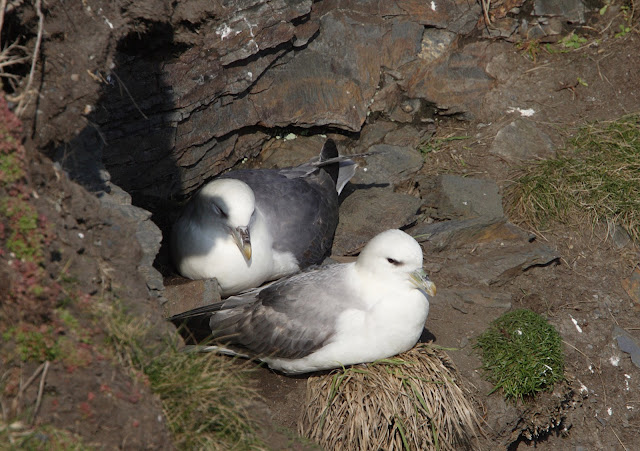Things have been a bit hectic of late and subsequently I have not had the chance to write any new posts, but the weather is grim outside this morning, so it seems like an opportune moment to update. Since my last post I have had a weekend in Cornwall, have done two Timed Tetrad Visits (for the BTO Atlas) and after a three week break, got to go ringing at Manor Farm Country Park.
Visits to Cornwall have been a regular thing for me over the last 30 years since my wife's family come from Boscastle. Over the years I have walked the valley's and the cliffs and have seen a few good birds, but this visit was more about just having a break and enjoying the local beer. The weather was not good on the journey down from Hampshire, and thick fog over Bodmin Moor made driving very difficult. But on Saturday morning the sky had cleared, the sun was blazing down and there seemed to be little wind....so ideal time for a walk.
We began our walk with a look out over the cliffs to the west of Boscastle and up Pentagon. On calm days this is a good place to look out for harbour porpoises or dolphins, but today, despite the lack of wind, there was an amazing swell on the sea. The waves were crashing against the base of the cliffs and creating spectacular displays of spray.
 |
| Crashing Waves, Boscastle February 2011 ©T. D. Codlin |
Given that it was still early February, I was a little surprised to see so many of the breeding birds back on the cliffs. Guillemots and razorbills were back of their precarious ledges, herring gulls were bickering over their nesting sites on the vegetated slopes and a single great black-backed gull commandeered top spot, and idly watched the goings on beneath....no doubt keeping a beady eye out for a tasty morsel! But for me, the highlight was to see fulmars back on the cliffs.
 |
| Fulmars Settled on Cliffs in Boscastle February 2011 ©T. D. Codlin |
The northern fulmar is a member of the shearwater/albatross family and birds spend the winter on the high seas, scavenging on any scraps that come their way. Like the other members of their family, their distinctive straight wings and habit of flying very low to the water, make them easy to pick out when compared with the lumbering flight of gulls. They breed on cliffs and this is the best time to see them at close quarters as they use the air currents to practice their aerial acrobatics.....
.......and give wannabe photographers the chance to practice their skills!!
 |
| Fulmar, Boscastle ©T. D. Codlin |
After a swift pub stop, well maybe not that swift, it was off up the Valency Valley in search of dippers. The valley is a great place to see this species, and personally I have never failed to see them there.
 |
| Valency Valley, Boscastle 2011 ©T. D. Codlin |
Looking at the above image, it is difficult to imagine that in 2004 this valley was decimated by a flood. The volume of water was such that the valley bottom was totally underwater, trees were ripped up and the vegetation washed away. Further downstream cars were washed into the sea and buildings were knocked down. Afterwards the gently meandering river had been replaced by a large straight scar through the valley bottom. Four years on though, its looking more like before. During the transitional period the dippers have remained in residence, and the lack of vegetation in places has in fact made them easier to see.
 |
| Dipper, Valency Valley February 2011 ©T. D. Codlin |
A new embankment formed by the torrent of water during the flood in 2004 has proved to be a very popular nesting site in recent years. This provides the ideal location for watching and photographing this often elusive species.
 |
| Dipper, Valency Valley February 2011 ©T. D. Codlin |
The above images show the rusty-brown feathers beneath the white bib which are a distinctive feature of the British, Irish and Central European subspecies. In North-west France and Northern Europe these feathers are dark brown.
 |
| Dipper, Valency Valley February 2011 ©T. D. Codlin |
The above individual spent ages sat on this rock; it was the only place where the sun was penetrating so I guess this bird was making the most of the additional warmth on offer. I was able to get quite close, and loved the way the light fell on the bird and the rock.
Back in Hampshire for the weekend of 19/20th February, and it was back down to Manor Farm Country Park for some bird ringing. The weekend began with an evening visit to try to catch some owls; there are at least two pairs of little owl on the park, so that species was to be the target. I put the nets up in a gap between two buildings, as I have seen owls flying between these buildings previously, and........
 |
| Adult Female Little Owl Manor Farm CP February 2011 ©T. D. Codlin |
 |
| Adult Female Little Owl Manor Farm CP February 2011 ©I. R. Phillips |
Stupidly I left my camera at home, but was saved by Izzy who had luckily brought hers (these are my old gnarled hands!!!). When you look at the size of this bird in relation to my hands you can see what a compact little bird it is.
 |
| Adult Female Little Owl Manor Farm CP February 2011 ©I. R. Phillips |
 |
| Treecreeper, Manor Farm CP February 2011 ©T. D. Codlin |













